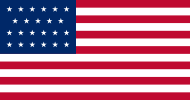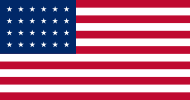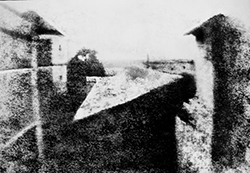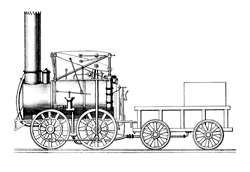MENU
The Electronic Scholarly Publishing Project: Providing access to classic scientific papers and other scholarly materials, since 1993. More About: ESP | OUR CONTENT | THIS WEBSITE | WHAT'S NEW | WHAT'S HOT
Comparative Timelines
The ESP Timeline (one of the site's most popular features) has been completely updated to allow the user to select (using the timeline controls above each column) different topics for the left and right sides of the display.
Select:
New Left Column
New Left Column
Dates
Decade
New Right Column
New Right Column
 The US flag is modified to have twenty-three stars, reflecting the addition of two new states: Alabama and Maine.
The US flag is modified to have twenty-three stars, reflecting the addition of two new states: Alabama and Maine.
Debate over slavery in the US heats up; The Missouri Compromise admits Maine into the Union as a free state, with Missouri to enter the next year as a slave state. Slavery is banned north of the 36 30' line of latitude in the Louisiana Territory.
Missouri Compromise Missouri is admitted to the Union as a slave state, Maine as a free state. Slavery is forbidden in any subsequent territories north of latitude .
The first Christian missionaries arrived in the Hawaiian Islands.
1820
The Arithmometer was the first commercially successful mechanical calculator patented
(no entry for this year)
1821
 Michael Faraday invents the electric motor and generator.
Michael Faraday invents the electric motor and generator.
 The US flag is modified to have twenty-four stars, reflecting the addition of one new state: Missouri.
The US flag is modified to have twenty-four stars, reflecting the addition of one new state: Missouri.
Slave Revolt: South Carolina Freed slave Denmark Vesey attempts a rebellion in Charleston. Thirty-five participants in the ill-fated uprising are hanged.
1822
Charles Babbage takes first steps in the construction of machines that would compute numbers
 Nic phore Ni pce abandons silver halide photography as hopelessly impermanent and tries using thin coatings of Bitumen of Judea on metal and glass. He creates the first fixed, permanent photograph, a copy of an engraving of Pope Pius VII, by contact printing in direct sunlight without a camera or lens. It is later destroyed; the earliest surviving example of his "heliographic process" is from 1825.
Nic phore Ni pce abandons silver halide photography as hopelessly impermanent and tries using thin coatings of Bitumen of Judea on metal and glass. He creates the first fixed, permanent photograph, a copy of an engraving of Pope Pius VII, by contact printing in direct sunlight without a camera or lens. It is later destroyed; the earliest surviving example of his "heliographic process" is from 1825.
Slavery is abolished in Chile.
1823
 Physicist Michael Faraday (1791-1867) describes the liquification of chlorine in On fluid chlorine. Faraday finds that gasses of certain kinds, when kept under constant pressure, will condense until they cool. This latter discovery ushers in the beginning of mechanical methods of refrigeration.
Physicist Michael Faraday (1791-1867) describes the liquification of chlorine in On fluid chlorine. Faraday finds that gasses of certain kinds, when kept under constant pressure, will condense until they cool. This latter discovery ushers in the beginning of mechanical methods of refrigeration.
Small-scale drilling for oil begins at Baku, a Russian port city on the west coast of the Caspian Sea, now the capital of Azerbaijan. The drilling marks the beginning of the modern petroleum industry, and by 1900 nearly half the world's oil will come from the Baku oil fields.
Mexico outlaws slavery. This decision creates the incentive for Anglo Texans to fight for independence in 1835-1836.
Mexico becomes a republic, three years after declaring independence from Spain.
1824
 Nic phore Ni pce makes the first durable, light-fast camera photograph, similar to his surviving 1826-1827 photograph on pewter but created on the surface of a lithographic stone. It is destroyed in the course of subsequent experiments.
Nic phore Ni pce makes the first durable, light-fast camera photograph, similar to his surviving 1826-1827 photograph on pewter but created on the surface of a lithographic stone. It is destroyed in the course of subsequent experiments.
1825
The Erie Canal (from Albany to Buffalo, New York) opens on October 26, connecting the Midwestern U.S. with the Atlantic Ocean, via the Great Lakes, and stimulating the development of Fort Dearborn (know today as Chicago), Cleveland and Columbus Ohio, and upstate New York cities like Rochester, Syracuse and Little Falls.
The first passenger steam railway opens, between Stockton and Darlington, England.
(no entry for this year)
1826
 Photograph by Joseph Ni pce: View from the Window at Le Gras, the world's first permanent photograph.
Photograph by Joseph Ni pce: View from the Window at Le Gras, the world's first permanent photograph.
 The first photographic images produced by Joseph-Nicéphore Ni pce
The first photographic images produced by Joseph-Nicéphore Ni pce
(no entry for this year)
1827
(no entry for this year)
(no entry for this year)
1828
(no entry for this year)
 Andrew Jackson becomes the seventh president of the United States.
Andrew Jackson becomes the seventh president of the United States.
Slavery abolished in Mexico.
1829
 The first steam locomotive to operate on a U.S. railroad begins service between Carbondale and Honesdale, Pennsylvania. The engine, "The Stourbridge Lion", has been imported from the Stephenson Engine Works in London.
The first steam locomotive to operate on a U.S. railroad begins service between Carbondale and Honesdale, Pennsylvania. The engine, "The Stourbridge Lion", has been imported from the Stephenson Engine Works in London.
ESP Quick Facts
ESP Origins
In the early 1990's, Robert Robbins was a faculty member at Johns Hopkins, where he directed the informatics core of GDB — the human gene-mapping database of the international human genome project. To share papers with colleagues around the world, he set up a small paper-sharing section on his personal web page. This small project evolved into The Electronic Scholarly Publishing Project.
ESP Support
In 1995, Robbins became the VP/IT of the Fred Hutchinson Cancer Research Center in Seattle, WA. Soon after arriving in Seattle, Robbins secured funding, through the ELSI component of the US Human Genome Project, to create the original ESP.ORG web site, with the formal goal of providing free, world-wide access to the literature of classical genetics.
ESP Rationale
Although the methods of molecular biology can seem almost magical to the uninitiated, the original techniques of classical genetics are readily appreciated by one and all: cross individuals that differ in some inherited trait, collect all of the progeny, score their attributes, and propose mechanisms to explain the patterns of inheritance observed.
ESP Goal
In reading the early works of classical genetics, one is drawn, almost inexorably, into ever more complex models, until molecular explanations begin to seem both necessary and natural. At that point, the tools for understanding genome research are at hand. Assisting readers reach this point was the original goal of The Electronic Scholarly Publishing Project.
ESP Usage
Usage of the site grew rapidly and has remained high. Faculty began to use the site for their assigned readings. Other on-line publishers, ranging from The New York Times to Nature referenced ESP materials in their own publications. Nobel laureates (e.g., Joshua Lederberg) regularly used the site and even wrote to suggest changes and improvements.
ESP Content
When the site began, no journals were making their early content available in digital format. As a result, ESP was obliged to digitize classic literature before it could be made available. For many important papers — such as Mendel's original paper or the first genetic map — ESP had to produce entirely new typeset versions of the works, if they were to be available in a high-quality format.
ESP Help
Early support from the DOE component of the Human Genome Project was critically important for getting the ESP project on a firm foundation. Since that funding ended (nearly 20 years ago), the project has been operated as a purely volunteer effort. Anyone wishing to assist in these efforts should send an email to Robbins.
ESP Plans
With the development of methods for adding typeset side notes to PDF files, the ESP project now plans to add annotated versions of some classical papers to its holdings. We also plan to add new reference and pedagogical material. We have already started providing regularly updated, comprehensive bibliographies to the ESP.ORG site.
ESP Picks from Around the Web (updated 06 MAR 2017 )
Old Science

Weird Science

Treating Disease with Fecal Transplantation
Fossils of miniature humans (hobbits) discovered in Indonesia

Dinosaur tail, complete with feathers, found preserved in amber.
Astronomy

Mysterious fast radio burst (FRB) detected in the distant universe.